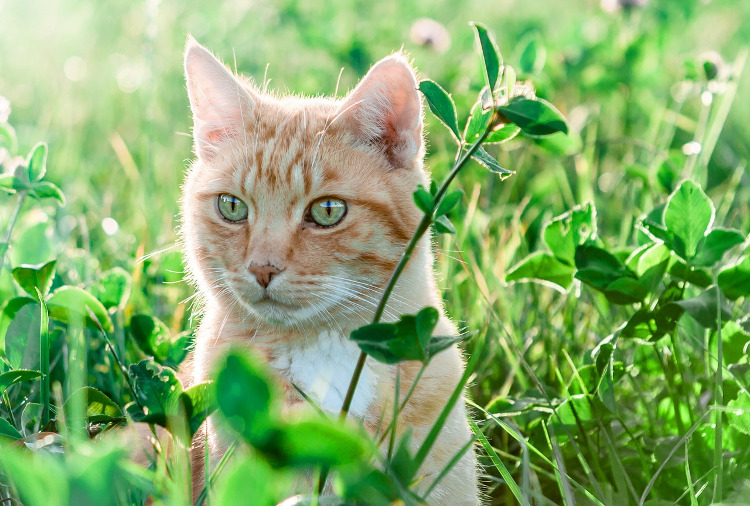![]()
Did you know that, like humans, cats can get pollen allergies too? Our cats can indeed become susceptible to environmental triggers and inhaled substances that cause allergies. Some cats may not develop these allergies until they are older, while for other cats their allergy symptoms may be exhibited early in life.
If left untreated, these pollen allergies can turn into skin itchiness, skin lesions, skin infections and respiratory symptoms including cold-like signs, which can become chronic. But what can you do to recognize and treat your cat if they have environmental allergies?
Symptoms
These are the most common signs of pollen allergies in cats:
- Scratching at skin and ears
- Overgrooming
- Head shaking
- Ear infection or odor
- Chewing on their paws
- Vomiting or hair balls
- Hair loss
- Sore-like lesions on the skin (also called eosinophilic plaques)
- Crusts on skin
- Lethargy
- Irritability
- Scratching at the eyes
- Watery eyes
- Runny nose
- Excessive coughing or sneezing
Causes
Pollen allergies surface when your cat inhales (inhalant allergy) or comes into direct contact with a substance (epicutaneous allergy), in this case pollen, which triggers an inappropriate response in the immune system. The over-reacting immune response typically manifests as inflammation of the skin and ears which can lead to itchiness and obvious redness or lesions at the skin. The inflammation and itchiness then makes the cat uncomfortable if it persists for a significant duration of time, leading to potential for self-trauma, secondary infection, and irritability.
Pollen can enter houses on our clothes and through open windows, making cats with a completely indoor lifestyle susceptible to pollen allergies in addition to cats that spend any amount of time outdoors.
Pollen is released by trees, grasses, and weeds during the appropriate pollination season. Depending on the season, multiple types of vegetation may be pollinating at the same time, leading to a pollen-rich environment. A pet may have no respite from pollen in the environment as pollen can fly miles from one region to another, and thus not having a certain tree in your neighbourhood does not mean that your cat is not exposed to a certain type of pollen.
Diagnosis
If you notice your cat showing any of the symptoms associated with allergies, it is time to see the vet, who will thoroughly examine your cat to rule out or differentiate between any environmental triggers, food ingredients, or skin parasites that may be responsible for the symptoms. It is best to provide your vet with a thorough medical history, including if there have been any changes to your cat’s housing, diet, bedding, or if there have been other changes within the home environment.
It can be helpful to document the progression of your cat’s symptoms, including if additional symptoms are occurring, and if your cat appears to get better or worse during certain times of the year. Making observations about a possible difference in symptoms related to spending time indoors versus outside (including balcony time or backyard time) can also help.
As allergies related to food, fleas and environmental triggers can exhibit similar symptoms, some preliminary testing may involve a strict diet trial and flea control prior to specifically working on pollen allergies. Your vet may conduct simple tests or treatments before determining if there is a need for evaluation of environmental allergies including pollen. A referral with a pet dermatologist is often discussed as an option at this time, or even before starting diet changes in some situations.
A vet dermatologist can help guide treatments and manage any complications to ensure adequate comfort for your cat during the process of finding a long-term plan to provide comfort to your cat. If pollen allergy is identified, intra-dermal allergy testing (similar to the scratch test for allergies in humans) will help identify the pollen causing the problem so that appropriate therapy can be designed for each individual cat. Serum allergy testing using a blood sample can also be used to determine allergies followed by an individualized plan to desensitize your pet against pollen allergies.
“How can I avoid my cat from contacting allergens?” Keeping your cat in a bubble to avoid allergens is not an option, thus desensitization therapy, which is quite safe and effective, is something to consider for all allergic cats, while they still live a happy and normal life.
Allergy testing can be a vital source of information that helps treat cats with environmental allergies. Once diagnosed, your vet dermatologist or family vet will find a program to keep your cat comfortable while desensitizing your cat against allergens causing the symptoms, or a conservative treatment plan based on symptoms and generally effective medications can be considered depending on the severity of the symptoms.
Although there is no cure for pollen allergies, if you continue with treatment upkeep with your pet skin specialist or vet, your cat will live a happier, healthier, and more comfortable life.
Creative Commons Attribution: Permission is granted to repost this article in its entirety with credit to VetDERM Clinic and a clickable link back to this page.

Dr. Jangi Bajwa is a Board certified veterinary dermatologist at VetDERM Clinic in Surrey BC. He is also the dermatology feature editor for Canadian Veterinary Journal. Dr. Bajwa’s special interests include otitis and allergic disease in pets; as well as helping improve quality of life of pets and their families.



 by
by